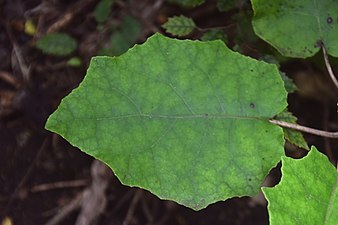Brachyglottis repanda
| Rangiora | |
|---|---|

| |
| Scientific classification | |
| Kingdom: | Plantae |
| Clade: | Tracheophytes |
| Clade: | Angiosperms |
| Clade: | Eudicots |
| Clade: | Asterids |
| Order: | Asterales |
| Family: | Asteraceae |
| Genus: | Brachyglottis |
| Species: | B. repanda
|
| Binomial name | |
| Brachyglottis repanda J.R.Forster & G.Forster
| |
Brachyglottis repanda, the rangiora or bushman's friend, is a small, bushy tree or tall shrub endemic to New Zealand. It grows to a height of 5 to 7 meters (16 to 23 ft). The petioles of the leaves have a characteristic groove up to 10 centimetres (3.9 in) long.[1] The large leaves with a soft furry underside have been referred to as "bushman's toilet paper".
Other common names in Māori (beyond rangiora) include: kōuaha, pukapuka, pukariao, puke-rangiora, raurākau, raurēkau, whārangi, or whārangi-tawhito.
Description
[edit]Rangiora is a shrub / small tree which grows to around 6 metres (20 ft) tall and has corky bark. It has leathery 5–25 centimetres (2.0–9.8 in) long, 5–20 centimetres (2.0–7.9 in) wide leaves suspended off of 8–10 centimetres (3.1–3.9 in) grooved petioles. The leaves are a pale green above and white underneath as the underside is covered with many tiny white hairs.[2] It flowers from August to October with dramatic panicle inflorescences made of six ribs and 3 millimetres (0.12 in) long involucral bracts. Pseudanthium are 5 millimetres (0.20 in) in diameter and the inflorescences contain 10–12 yellow florets. The seeds are oblong and 1–1.8 millimetres (0.039–0.071 in) long, with 2–3 millimetres (0.079–0.118 in) rough yellow pappus. It fruits from November to December and disperses its seeds via the wind.[3]
-
Leaf
-
Flowers
Etymology
[edit]Brachyglottis comes from the two greek words: Brachus, meaning short, and glottis which is the vocal apparatus of the larynx. Repanda means irregularly undulating, referring to the leaf margins.[3]
Cultivation
[edit]Rangiora is easy to grow either from seed or from cuttings, though may be short-lived and requires a hard prune after flowering.[3]
In Māori culture
[edit]Māori used the plant for a number of medicinal uses. Rangiora leaves were used for wounds and old ulcerated sores, and the gum was chewed for foul breath but was poisonous if swallowed.[4] The ethnographer Richard Taylor recorded that the leaves were used to wrap cakes made from hīnau berry meal while they cooked in a hāngī.[5] They were also used, he claimed, to line the baskets which held the siftings of raupō pollen in the process of making bread (from the pollen called pungapunga[6]), the siftings then being thrown out.[7]
Toxins
[edit]The botanist and chemist Bernard Aston reported that the honey made by bees produced with the nectar from rangiora is poisonous, and for this reason Māori never collected honey when it was in flower. The plant is also apparently poisonous to livestock, particularly horses, making them "drunk." The animals stagger around and fall, often to their death, as a result.[8]
Parasites
[edit]B. repanda plays host to the larvae of the moth species Stigmella cypracma.[9] The larvae mine the leaves of B. repanda leaving damaged leaves in their wake.[9]
References
[edit]- ^ "Brachyglottis repanda (Rangiora)". Terrain.net.nz.
- ^ Lehnebach, Carlos A.; Meudt, Heidi (1 October 2022). Native Plants of Aotearoa. Te Papa Te Taiao Nature Series. Te Papa Press. p. 59. ISBN 978-1-9911509-3-6.
- ^ a b c "Brachyglottis repanda". New Zealand Plant Conservation Network. Retrieved 19 December 2020.
- ^ Brooker, S. G.; R. C. Cambie; R.C. Cooper (1987). New Zealand Medicinal Plants. Reed Books. ISBN 0-7900-0250-7.
- ^ Taylor, Richard (1855). Te Ika a Maui, or, New Zealand and its inhabitants : with the geology, natural history, productions, and climate of the country, &c. London: Wertheim and Macintosh. p. 393.
- ^ Lehnebach, Carlos A.; Regnault, Claire; Rice, Rebecca; Awa, Isaac Te; Yates, Rachel A. (1 November 2023). Flora: Celebrating our Botanical World. Te Papa Press. p. 140. ISBN 978-1-9911509-1-2.
- ^ Taylor, Richard (1855). Te Ika a Maui, or, New Zealand and its inhabitants : with the geology, natural history, productions, and climate of the country, &c. London: Wertheim and Macintosh. p. 392.
- ^ ASTON, B. C. "THE POISONOUS, SUSPECTED, AND MEDICINAL PLANTS OF NEW ZEALAND" (PDF). New Zealand Journal of Agriculture. feb. 20. 1923: 80–81 – via Botanical Dermatology Database.
- ^ a b Morris N. Watt (1921). "The Leaf-mining Insects of New Zealand: Part II". Transactions and Proceedings of the New Zealand Institute. 53: 207–212. ISSN 1176-6158. Wikidata Q122940161. This article incorporates text from this source, which is in the public domain.
External links
[edit]![]() Media related to Brachyglottis repanda at Wikimedia Commons
Media related to Brachyglottis repanda at Wikimedia Commons


